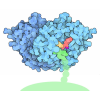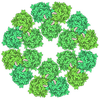+ Open data
Open data
- Basic information
Basic information
| Entry |  | |||||||||
|---|---|---|---|---|---|---|---|---|---|---|
| Title | TcdB1 in complex with mini-binder | |||||||||
 Map data Map data | ||||||||||
 Sample Sample |
| |||||||||
 Keywords Keywords | Mini-binder against C.difficle infection / TOXIN-DE NOVO PROTEIN complex | |||||||||
| Function / homology |  Function and homology information Function and homology informationsymbiont-mediated perturbation of host actin cytoskeleton via filamentous actin depolymerization / glucosyltransferase activity / Transferases; Glycosyltransferases; Hexosyltransferases / host cell cytosol / cysteine-type peptidase activity / host cell endosome membrane / toxin activity / Hydrolases; Acting on peptide bonds (peptidases); Cysteine endopeptidases / lipid binding / host cell plasma membrane ...symbiont-mediated perturbation of host actin cytoskeleton via filamentous actin depolymerization / glucosyltransferase activity / Transferases; Glycosyltransferases; Hexosyltransferases / host cell cytosol / cysteine-type peptidase activity / host cell endosome membrane / toxin activity / Hydrolases; Acting on peptide bonds (peptidases); Cysteine endopeptidases / lipid binding / host cell plasma membrane / proteolysis / extracellular region / metal ion binding / membrane Similarity search - Function | |||||||||
| Biological species |  Clostridioides difficile (bacteria) / synthetic construct (others) Clostridioides difficile (bacteria) / synthetic construct (others) | |||||||||
| Method | single particle reconstruction / cryo EM / Resolution: 3.2 Å | |||||||||
 Authors Authors | Lv XC / Lu PL | |||||||||
| Funding support |  China, 2 items China, 2 items
| |||||||||
 Citation Citation |  Journal: Nat Commun / Year: 2024 Journal: Nat Commun / Year: 2024Title: De novo design of mini-protein binders broadly neutralizing Clostridioides difficile toxin B variants. Authors: Xinchen Lv / Yuanyuan Zhang / Ke Sun / Qi Yang / Jianhua Luo / Liang Tao / Peilong Lu /  Abstract: Clostridioides difficile toxin B (TcdB) is the key virulence factor accounting for C. difficile infection-associated symptoms. Effectively neutralizing different TcdB variants with a universal ...Clostridioides difficile toxin B (TcdB) is the key virulence factor accounting for C. difficile infection-associated symptoms. Effectively neutralizing different TcdB variants with a universal solution poses a significant challenge. Here we present the de novo design and characterization of pan-specific mini-protein binders against major TcdB subtypes. Our design successfully binds to the first receptor binding interface (RBI-1) of the varied TcdB subtypes, exhibiting affinities ranging from 20 pM to 10 nM. The cryo-electron microscopy (cryo-EM) structures of the mini protein binder in complex with TcdB1 and TcdB4 are consistent with the computational design models. The engineered and evolved variants of the mini-protein binder and chondroitin sulfate proteoglycan 4 (CSPG4), another natural receptor that binds to the second RBI (RBI-2) of TcdB, better neutralize major TcdB variants both in cells and in vivo, as demonstrated by the colon-loop assay using female mice. Our findings provide valuable starting points for the development of therapeutics targeting C. difficile infections (CDI). | |||||||||
| History |
|
- Structure visualization
Structure visualization
| Supplemental images |
|---|
- Downloads & links
Downloads & links
-EMDB archive
| Map data |  emd_39072.map.gz emd_39072.map.gz | 118.1 MB |  EMDB map data format EMDB map data format | |
|---|---|---|---|---|
| Header (meta data) |  emd-39072-v30.xml emd-39072-v30.xml emd-39072.xml emd-39072.xml | 20.2 KB 20.2 KB | Display Display |  EMDB header EMDB header |
| FSC (resolution estimation) |  emd_39072_fsc.xml emd_39072_fsc.xml | 14.6 KB | Display |  FSC data file FSC data file |
| Images |  emd_39072.png emd_39072.png | 37.2 KB | ||
| Filedesc metadata |  emd-39072.cif.gz emd-39072.cif.gz | 7.2 KB | ||
| Others |  emd_39072_additional_1.map.gz emd_39072_additional_1.map.gz emd_39072_half_map_1.map.gz emd_39072_half_map_1.map.gz emd_39072_half_map_2.map.gz emd_39072_half_map_2.map.gz | 118.1 MB 116 MB 116 MB | ||
| Archive directory |  http://ftp.pdbj.org/pub/emdb/structures/EMD-39072 http://ftp.pdbj.org/pub/emdb/structures/EMD-39072 ftp://ftp.pdbj.org/pub/emdb/structures/EMD-39072 ftp://ftp.pdbj.org/pub/emdb/structures/EMD-39072 | HTTPS FTP |
-Validation report
| Summary document |  emd_39072_validation.pdf.gz emd_39072_validation.pdf.gz | 895.9 KB | Display |  EMDB validaton report EMDB validaton report |
|---|---|---|---|---|
| Full document |  emd_39072_full_validation.pdf.gz emd_39072_full_validation.pdf.gz | 895.4 KB | Display | |
| Data in XML |  emd_39072_validation.xml.gz emd_39072_validation.xml.gz | 18.8 KB | Display | |
| Data in CIF |  emd_39072_validation.cif.gz emd_39072_validation.cif.gz | 24.8 KB | Display | |
| Arichive directory |  https://ftp.pdbj.org/pub/emdb/validation_reports/EMD-39072 https://ftp.pdbj.org/pub/emdb/validation_reports/EMD-39072 ftp://ftp.pdbj.org/pub/emdb/validation_reports/EMD-39072 ftp://ftp.pdbj.org/pub/emdb/validation_reports/EMD-39072 | HTTPS FTP |
-Related structure data
| Related structure data |  8y9bMC  8y9cC M: atomic model generated by this map C: citing same article ( |
|---|---|
| Similar structure data | Similarity search - Function & homology  F&H Search F&H Search |
- Links
Links
| EMDB pages |  EMDB (EBI/PDBe) / EMDB (EBI/PDBe) /  EMDataResource EMDataResource |
|---|---|
| Related items in Molecule of the Month |
- Map
Map
| File |  Download / File: emd_39072.map.gz / Format: CCP4 / Size: 125 MB / Type: IMAGE STORED AS FLOATING POINT NUMBER (4 BYTES) Download / File: emd_39072.map.gz / Format: CCP4 / Size: 125 MB / Type: IMAGE STORED AS FLOATING POINT NUMBER (4 BYTES) | ||||||||||||||||||||||||||||||||||||
|---|---|---|---|---|---|---|---|---|---|---|---|---|---|---|---|---|---|---|---|---|---|---|---|---|---|---|---|---|---|---|---|---|---|---|---|---|---|
| Projections & slices | Image control
Images are generated by Spider. | ||||||||||||||||||||||||||||||||||||
| Voxel size | X=Y=Z: 1.087 Å | ||||||||||||||||||||||||||||||||||||
| Density |
| ||||||||||||||||||||||||||||||||||||
| Symmetry | Space group: 1 | ||||||||||||||||||||||||||||||||||||
| Details | EMDB XML:
|
-Supplemental data
- Sample components
Sample components
-Entire : De novo design mini-binder in complex with TcdB1
| Entire | Name: De novo design mini-binder in complex with TcdB1 |
|---|---|
| Components |
|
-Supramolecule #1: De novo design mini-binder in complex with TcdB1
| Supramolecule | Name: De novo design mini-binder in complex with TcdB1 / type: complex / ID: 1 / Parent: 0 / Macromolecule list: #1-#2 |
|---|---|
| Source (natural) | Organism:  Clostridioides difficile (bacteria) Clostridioides difficile (bacteria) |
-Macromolecule #1: Toxin B
| Macromolecule | Name: Toxin B / type: protein_or_peptide / ID: 1 / Number of copies: 1 / Enantiomer: LEVO EC number: Hydrolases; Acting on peptide bonds (peptidases); Cysteine endopeptidases |
|---|---|
| Source (natural) | Organism:  Clostridioides difficile (bacteria) Clostridioides difficile (bacteria) |
| Molecular weight | Theoretical: 270.767281 KDa |
| Recombinant expression | Organism:  |
| Sequence | String: MSLVNRKQLE KMANVRFRTQ EDEYVAILDA LEEYHNMSEN TVVEKYLKLK DINSLTDIYI DTYKKSGRNK ALKKFKEYLV TEVLELKNN NLTPVEKNLH FVWIGGQIND TAINYINQWK DVNSDYNVNV FYDSNAFLIN TLKKTVVESA INDTLESFRE N LNDPRFDY ...String: MSLVNRKQLE KMANVRFRTQ EDEYVAILDA LEEYHNMSEN TVVEKYLKLK DINSLTDIYI DTYKKSGRNK ALKKFKEYLV TEVLELKNN NLTPVEKNLH FVWIGGQIND TAINYINQWK DVNSDYNVNV FYDSNAFLIN TLKKTVVESA INDTLESFRE N LNDPRFDY NKFFRKRMEI IYDKQKNFIN YYKAQREENP ELIIDDIVKT YLSNEYSKEI DELNTYIEES LNKITQNSGN DV RNFEEFK NGESFNLYEQ ELVERWNLAA ASDILRISAL KEIGGMYLDV DMLPGIQPDL FESIEKPSSV TVDFWEMTKL EAI MKYKEY IPEYTSEHFD MLDEEVQSSF ESVLASKSDK SEIFSSLGDM EASPLEVKIA FNSKGIINQG LISVKDSYCS NLIV KQIEN RYKILNNSLN PAISEDNDFN TTTNTFIDSI MAEANADNGR FMMELGKYLR VGFFPDVKTT INLSGPEAYA AAYQD LLMF KEGSMNIHLI EADLRNFEIS KTNISQSTEQ EMASLWSFDD ARAKAQFEEY KRNYFEGSLG EDDNLDFSQN IVVDKE YLL EKISSLARSS ERGYIHYIVQ LQGDKISYEA ACNLFAKTPY DSVLFQKNIE DSEIAYYYNP GDGEIQEIDK YKIPSII SD RPKIKLTFIG HGKDEFNTDI FAGFDVDSLS TEIEAAIDLA KEDISPKSIE INLLGCNMFS YSINVEETYP GKLLLKVK D KISELMPSIS QDSIIVSANQ YEVRINSEGR RELLDHSGEW INKEESIIKD ISSKEYISFN PKENKITVKS KNLPELSTL LQEIRNNSNS SDIELEEKVM LTECEINVIS NIDTQIVEER IEEAKNLTSD SINYIKDEFK LIESISDALC DLKQQNELED SHFISFEDI SETDEGFSIR FINKETGESI FVETEKTIFS EYANHITEEI SKIKGTIFDT VNGKLVKKVN LDTTHEVNTL N AAFFIQSL IEYNSSKESL SNLSVAMKVQ VYAQLFSTGL NTITDAAKVV ELVSTALDET IDLLPTLSEG LPIIATIIDG VS LGAAIKE LSETSDPLLR QEIEAKIGIM AVNLTTATTA IITSSLGIAS GFSILLVPLA GISAGIPSLV NNELVLRDKA TKV VDYFKH VSLVETEGVF TLLDDKIMMP QDDLVISEID FNNNSIVLGK CEIWRMEGGS GHTVTDDIDH FFSAPSITYR EPHL SIYDV LEVQKEELDL SKDLMVLPNA PNRVFAWETG WTPGLRSLEN DGTKLLDRIR DNYEGEFYWR YFAFIADALI TTLKP RYED TNIRINLDSN TRSFIVPIIT TEYIREKLSY SFYGSGGTYA LSLSQYNMGI NIELSESDVW IIDVDNVVRD VTIESD KIK KGDLIEGILS TLSIEENKII LNSHEINFSG EVNGSNGFVS LTFSILEGIN AIIEVDLLSK SYKLLISGEL KILMLNS NH IQQKIDYIGF NSELQKNIPY SFVDSEGKEN GFINGSTKEG LFVSELPDVV LISKVYMDDS KPSFGYYSNN LKDVKVIT K DNVNILTGYY LKDDIKISLS LTLQDEKTIK LNSVHLDESG VAEILKFMNR KGNTNTSDSL MSFLESMNIK SIFVNFLQS NIKFILDANF IISGTTSIGQ FEFICDENDN IQPYFIKFNT LETNYTLYVG NRQNMIVEPN YDLDDSGDIS STVINFSQKY LYGIDSCVN KVVISPNIYT DEINITPVYE TNNTYPEVIV LDANYINEKI NVNINDLSIR YVWSNDGNDF ILMSTSEENK V SQVKIRFV NVFKDKTLAN KLSFNFSDKQ DVPVSEIILS FTPSYYEDGL IGYDLGLVSL YNEKFYINNF GMMVSGLIYI ND SLYYFKP PVNNLITGFV TVGDDKYYFN PINGGAASIG ETIIDDKNYY FNQSGVLQTG VFSTEDGFKY FAPANTLDEN LEG EAIDFT GKLIIDENIY YFDDNYRGAV EWKELDGEMH YFSPETGKAF KGLNQIGDYK YYFNSDGVMQ KGFVSINDNK HYFD DSGVM KVGYTEIDGK HFYFAENGEM QIGVFNTEDG FKYFAHHNED LGNEEGEEIS YSGILNFNNK IYYFDDSFTA VVGWK DLED GSKYYFDEDT AEAYIGLSLI NDGQYYFNDD GIMQVGFVTI NDKVFYFSDS GIIESGVQNI DDNYFYIDDN GIVQIG VFD TSDGYKYFAP ANTVNDNIYG QAVEYSGLVR VGEDVYYFGE TYTIETGWIY DMENESDKYY FNPETKKACK GINLIDD IK YYFDEKGIMR TGLISFENNN YYFNENGEMQ FGYINIEDKM FYFGEDGVMQ IGVFNTPDGF KYFAHQNTLD ENFEGESI N YTGWLDLDEK RYYFTDEYIA ATGSVIIDGE EYYFDPDTAQ LVISEHHHHH H UniProtKB: Toxin B |
-Macromolecule #2: De novo design mini-binder
| Macromolecule | Name: De novo design mini-binder / type: protein_or_peptide / ID: 2 / Number of copies: 1 / Enantiomer: LEVO |
|---|---|
| Source (natural) | Organism: synthetic construct (others) |
| Molecular weight | Theoretical: 7.43746 KDa |
| Recombinant expression | Organism:  |
| Sequence | String: NEEEKFKFFV WFLAIRAGVP EVEVRNDNGK FQVTVKGDTD AARLLTKEVK EVATFLGVDV DLQIR |
-Macromolecule #3: ZINC ION
| Macromolecule | Name: ZINC ION / type: ligand / ID: 3 / Number of copies: 1 / Formula: ZN |
|---|---|
| Molecular weight | Theoretical: 65.409 Da |
-Experimental details
-Structure determination
| Method | cryo EM |
|---|---|
 Processing Processing | single particle reconstruction |
| Aggregation state | particle |
- Sample preparation
Sample preparation
| Concentration | 6 mg/mL | |||||||||
|---|---|---|---|---|---|---|---|---|---|---|
| Buffer | pH: 7 Component:
| |||||||||
| Vitrification | Cryogen name: ETHANE |
- Electron microscopy
Electron microscopy
| Microscope | FEI TITAN KRIOS |
|---|---|
| Image recording | Film or detector model: GATAN K3 (6k x 4k) / Average electron dose: 50.0 e/Å2 |
| Electron beam | Acceleration voltage: 300 kV / Electron source:  FIELD EMISSION GUN FIELD EMISSION GUN |
| Electron optics | Illumination mode: FLOOD BEAM / Imaging mode: BRIGHT FIELD / Nominal defocus max: 2.0 µm / Nominal defocus min: 1.4000000000000001 µm |
| Experimental equipment |  Model: Titan Krios / Image courtesy: FEI Company |
 Movie
Movie Controller
Controller








 Z (Sec.)
Z (Sec.) Y (Row.)
Y (Row.) X (Col.)
X (Col.)























